
T R A C H Y P H O N U S S Q U A M I C E P S
T R A C H Y P H O N U S S Q U A M I C E P S.
( L E S S E R P E A R L - S P O T T E D B A R B E T .)
Trachjphonus squamiceps (1857) H e u g l . S y s t . U e b e r s , p . 4 7 .
„ „ (1857) H a r t l . O m . " W . A f r . p . 1 7 6 , note.
„ „ (1861) H e u g l . I b i s , p . 1 2 5 .
„ (1868) G . E . G r . C a t . B r i t . M u s . O a p i t . p . 1 8 .
Capito squamiceps (1863) G o f f i n , M u s . P a y s B a s . B u c c . p . 7 0 .
T . s e x i b u s s i m i l i b u s : m i n o r : s u p r a t o r r i c o l o r , a l b o p u n e t a t u s : o c c i p i t e c r i s t a t o : s u b t u s s q u a m a t u s.
Hob. in Africa septentrionali-orientali.
Sexes alike; entire head, which is fully crested, black; the feathers are elastic and
hornlike in structure and barred with fiery yellow; back and wings earthy brown, with round
cream coloured spots near the tip of each feather; these spots are only on t h e exterior web of
the primaries and secondaries; their inner webs are pale yellowish at the b a s e ; the lower
back and rump earthy brown, barred with sulphur yellow; upper tail-coverts sulphur yellow.
The tail is dark brown, long, and slightly rounded, the outer pair of feathers barred, t he
remainder spotted with yeUowish white, the spots lessening towards the centre pair. The
cheeks, throat, and breast are sulphur yellow, each feather tipped with a small round black
spot, the throat is washed with scarlet, a few feathers in t h e centre of t h e breast barred with
black, forming an irregular spot; the abdomen and vent are pale yellow, indistinctly
speckled with light brown; flanks and under wing-coverts grey, under tail-coverts bright
scarlet. Bill ashy flesh cobalt, hides brown. Legs and feet plumbeous. Wing 2'6,
tail 2'8, length 6 inches.
Hah. North Eastern Africa ; Western shore of t h e Bahr-el-abiad (Heuglin).
This beautiful little Barbet is a comparatively recent addition to the known species of
this family. It was discovered by Dr. von Ileuglin in Eastern Africa, and according to his
account, i ts habits are sociable, and i ts breeding and food the same as those of P. diadematus.